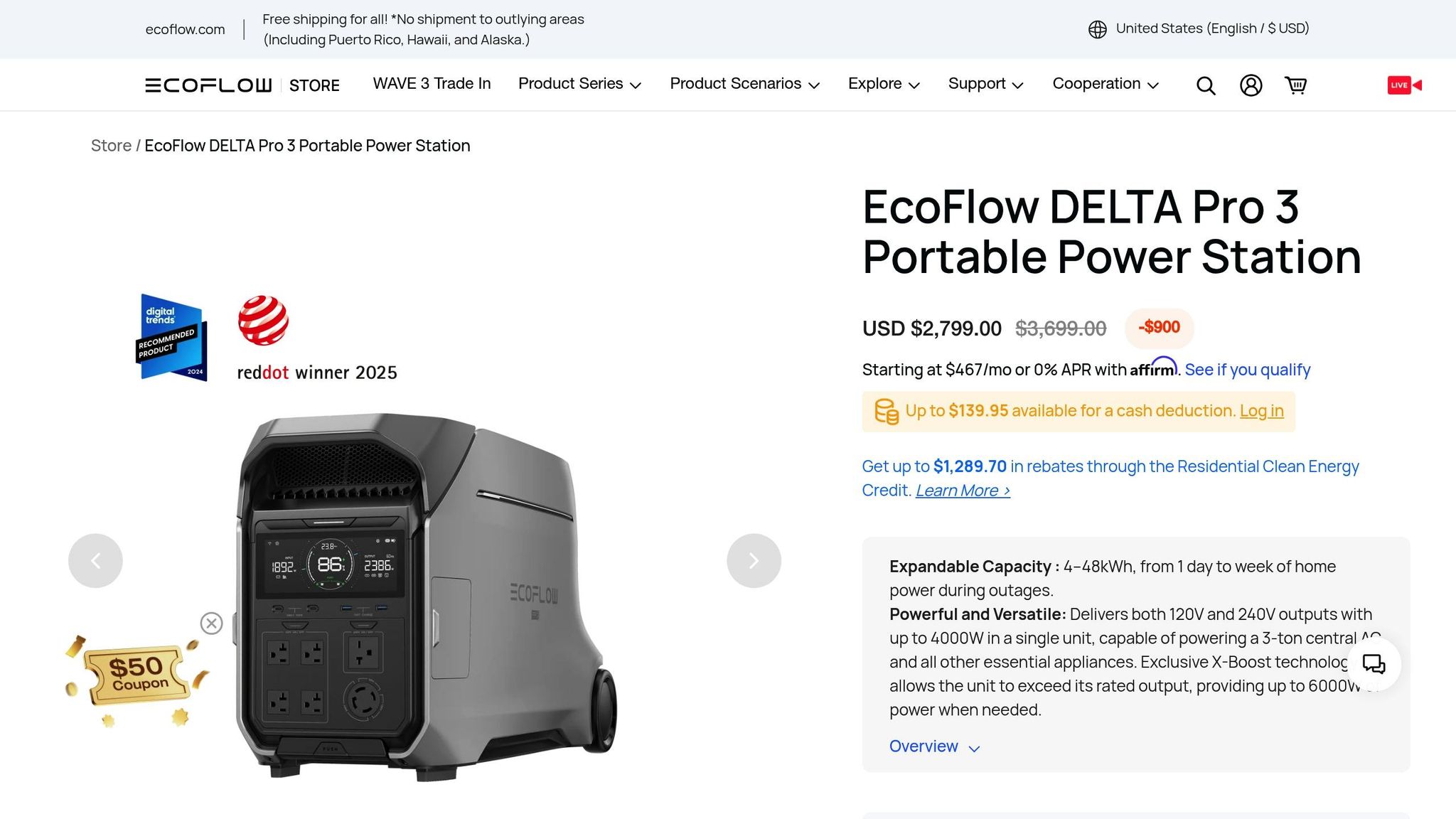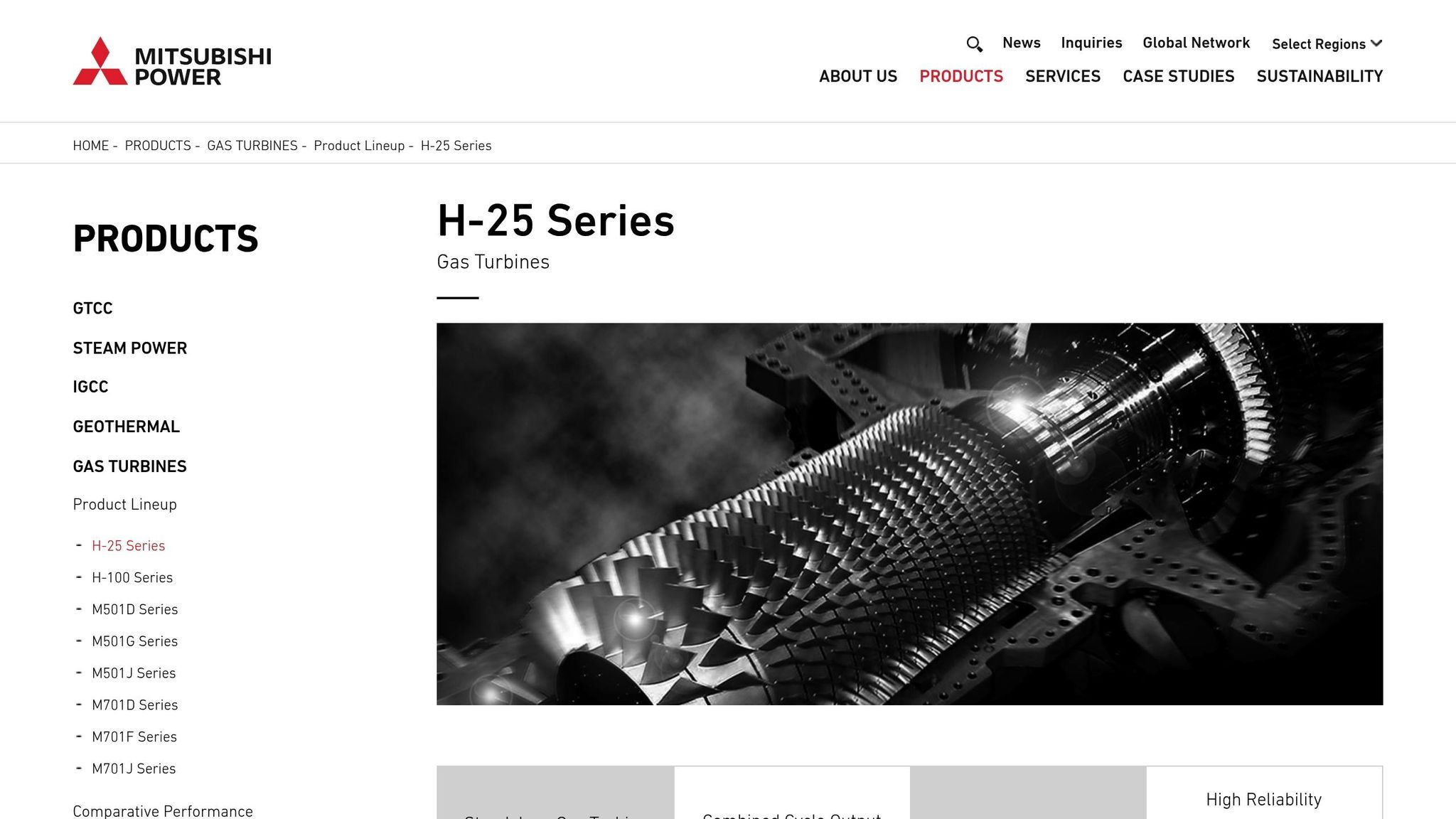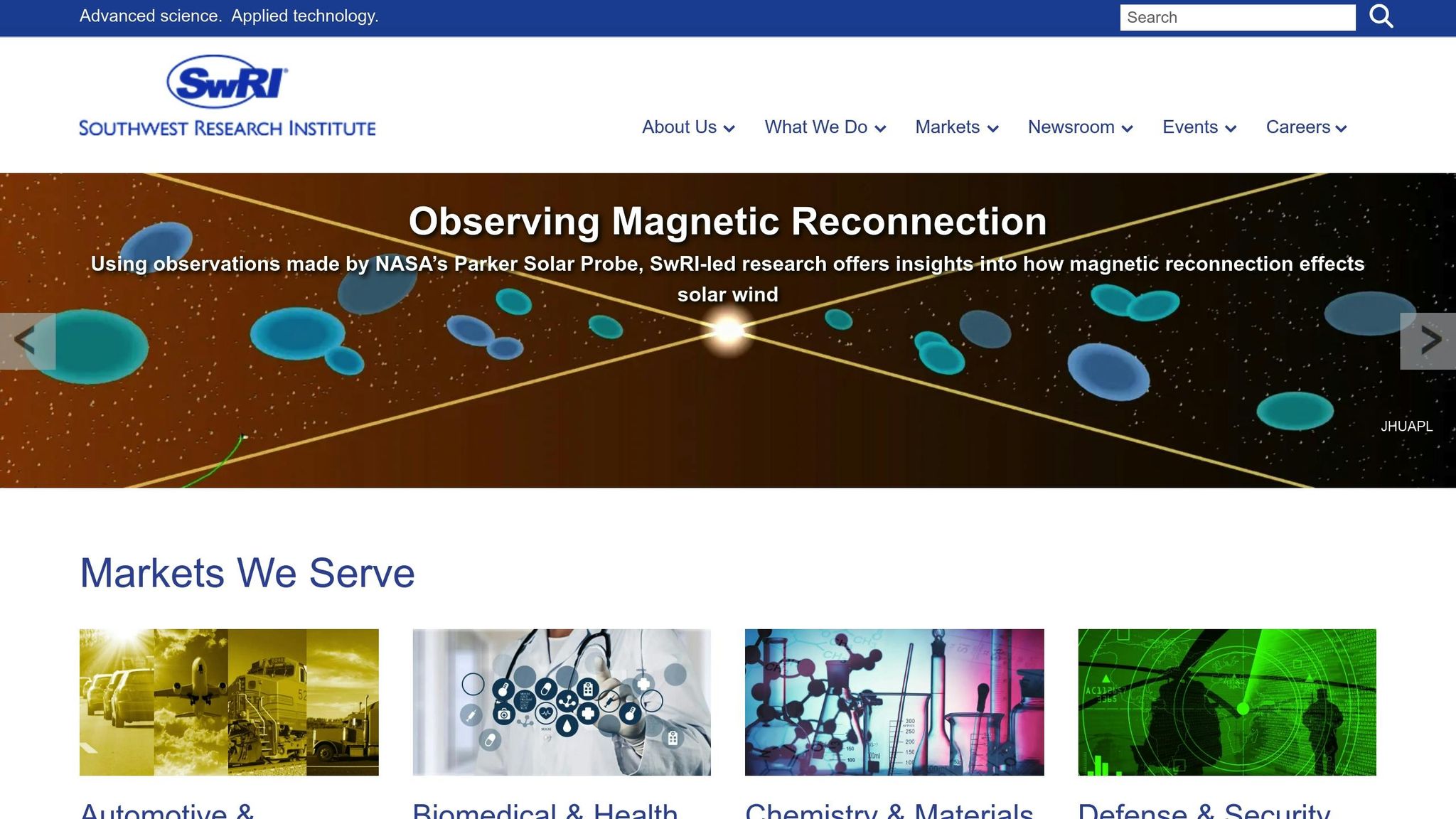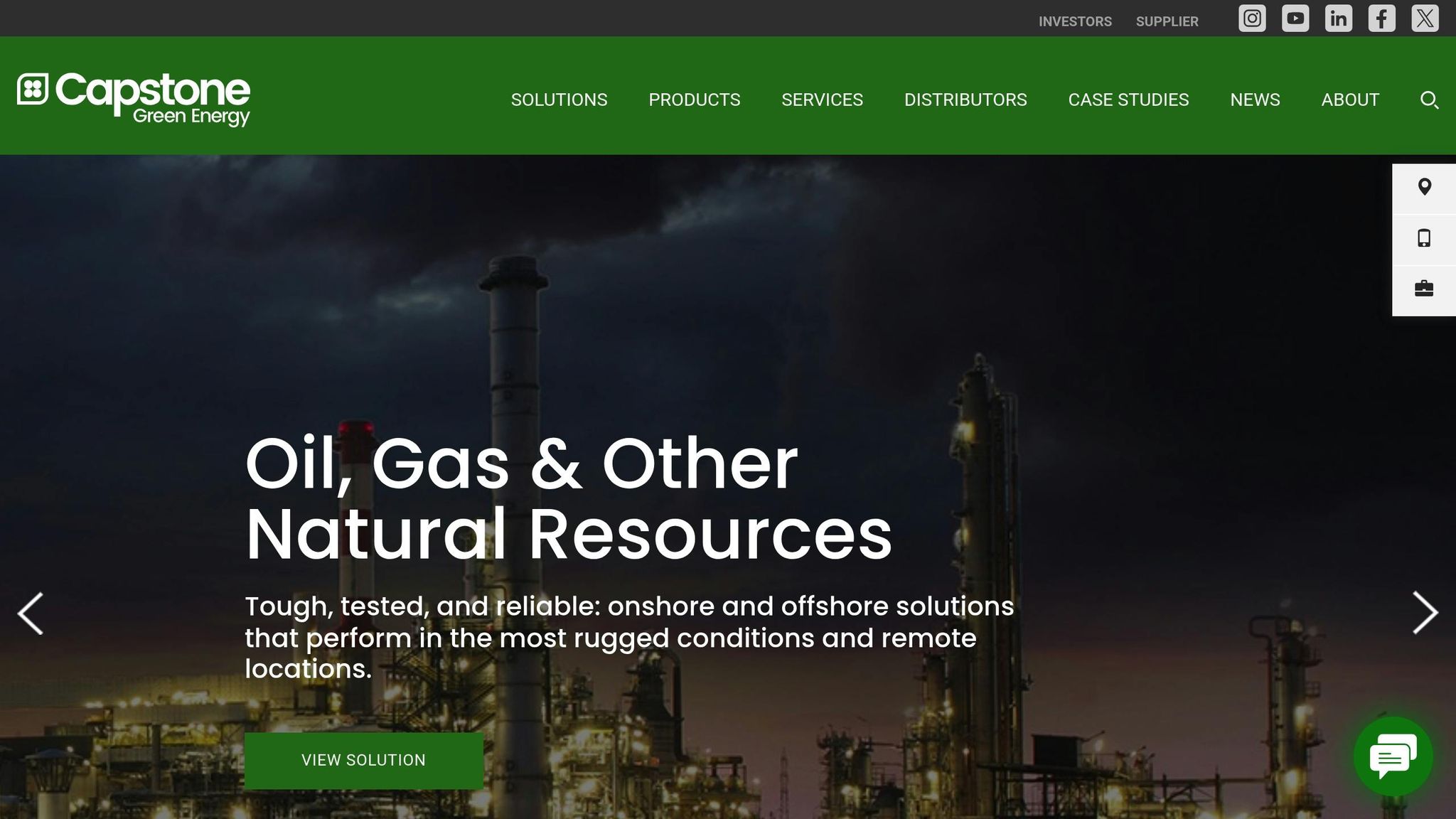
Top 5 Power Generation Tools for 2025
Share
Looking for the best power generation tools in 2025? Here's a quick guide to the top technologies meeting rising energy demands while supporting clean, efficient energy systems. Whether you're after portable solutions for emergencies or industrial-scale power generation, these tools deliver on performance, sustainability, and innovation.
Key Highlights:
- EcoFlow DELTA Pro 3: A portable power station with 4,096Wh capacity, 6,000W output (X-Boost), and fast charging in under an hour. Perfect for home backup and off-grid use.
- Mitsubishi Power H-25 Gas Turbine: Industrial-scale turbine producing up to 121.4 MW with 54.5% efficiency in combined cycle mode. Supports hydrogen and ammonia fuels for cleaner energy.
- SwRI LMRC Compressor: Leak-proof hydrogen compressor designed for fuel cell vehicles and industrial applications, ensuring efficiency and safety.
- Capstone C200S Microturbine: A 200kW distributed energy solution with 90% combined heat and power efficiency, capable of running on renewable and waste gases.
- VTOMAN FlashSpeed 1500: Compact power station with 1,548Wh capacity, solar compatibility, and expandable battery options for off-grid and emergency power needs.
Quick Comparison:
| Tool | Type | Power Output | Key Features | Price |
|---|---|---|---|---|
| EcoFlow DELTA Pro 3 | Portable Station | 4,000W (6,000W X-Boost) | 4,096Wh, fast charging, expandable to 48kWh | $2,799 |
| Mitsubishi H-25 Series | Industrial Turbine | Up to 121.4 MW | 54.5% efficiency, hydrogen/ammonia fuel capability | Millions |
| SwRI LMRC Compressor | Hydrogen Compressor | Variable | Leak-proof, oil-free, supports hydrogen refueling | $1M-$3M |
| Capstone C200S Microturbine | Microturbine | 200kW | 90% CHP efficiency, runs on renewable/waste gases | $500K-$1M |
| VTOMAN FlashSpeed 1500 | Portable Station | 1,500W (3,000W peak) | 1,548Wh, solar input, expandable battery | $999.99 |
These tools represent the forefront of power generation technology, addressing diverse needs from personal backup power to large-scale industrial applications. Dive into the full article for detailed specs and practical use cases.
Best Home Solar Generators for 2025
1. EcoFlow DELTA Pro 3 Portable Power Station

As energy needs grow, the EcoFlow DELTA Pro 3 steps up with a portable design that delivers commercial-level power. With a surge capacity of up to 8,000W, it’s built to handle everything from home backup power to demanding commercial tasks.
Power Output and Efficiency
This powerhouse features a 4,096Wh battery capable of supporting 120V/240V AC. Thanks to its X-Boost mode, it can deliver up to 6,000W, while its inverter operates at over 90% efficiency with minimal idle power consumption (15–18W). Using LiFePO4 battery technology, the DELTA Pro 3 is rated for 4,000 full recharge cycles while maintaining at least 80% of its original capacity - equivalent to around 11 years of daily use.
| Feature | Specification |
|---|---|
| Rated Capacity | 4,096Wh |
| AC Continuous Output | 4,000W (6,000W with X-Boost) |
| AC Surge Output | 8,000W |
| 120V AC Output | 4 x NEMA 5-20R (20A), 1 x NEMA TT-30R (30A) |
| 240V AC Output | 1 x NEMA 6-20R (16.7A), 1 x NEMA L14-30R (16.7A) |
| USB-C Output | 2 x 100W Max per port, 200W total |
| Cycle Life | 4,000 cycles to 80% capacity |
| UPS Switchover | 10 ms |
Advanced Features and Technology
The DELTA Pro 3 incorporates cutting-edge technology to boost performance and safety. Its X-Core 3.0 architecture combines AI, cloud connectivity, and IoT to optimize operation. Equipped with X-Stream fast charging, it can go from 0% to 80% charge in just 50 minutes, making it perfect for emergencies. The integrated Battery Management System (BMS), powered by X-Guard, actively monitors 44 safety parameters.
"DELTA Pro 3 challenges the status quo of traditional gas generators and addresses longstanding issues their users have struggled with for decades. It represents a culmination of next-generation technologies we have developed in-house to improve the user experience and expand on what people even think is possible with a portable power station."
- Brian Essenmacher, EcoFlow's North American head of business development
Built for durability, the unit features a UL-certified 5VA fireproof shell and IP65-rated protection against dust and water. Its X-Quiet technology ensures the device operates at a whisper-quiet 30 dB.
Versatile Applications
The DELTA Pro 3 is designed to adapt to various scenarios, whether at home or on a job site. For residential use, it can keep essential appliances running during power outages. Its capacity is expandable up to 48kWh when paired with additional batteries and smart generators. The seamless UPS feature ensures sensitive electronics remain unaffected by power interruptions.
In commercial settings, its high continuous output can handle heavy-duty equipment and tools. With multiple charging options - AC wall outlets, solar panels, car utility sockets, EV chargers, or generators - it’s ready for diverse environments. The dual PV charging capability supports both high- and low-voltage solar panels, and it integrates easily with existing EcoFlow devices.
Focus on Sustainability
The DELTA Pro 3 emphasizes safety and longevity with its LiFePO4 battery chemistry, while solar charging offers a greener, carbon-free power option. The dual PV system optimizes solar input, enhancing efficiency.
Starting at $2,799, the DELTA Pro 3 has earned a 4.5 out of 5-star rating from 217 Amazon reviews. The Wall Street Journal highlighted its versatility, calling it "one of the most versatile power stations available".
This combination of performance and adaptability sets a high bar as we delve into the next contender in portable power solutions.
2. Mitsubishi Power H-25 Series Gas Turbine

Shifting from portable solutions to industrial-scale energy production, the Mitsubishi Power H-25 Series stands out as a powerhouse in gas turbine technology. Built for utility and industrial applications, this heavy-duty turbine delivers dependable, high-output energy while offering remarkable fuel flexibility. It reflects the industry's move towards robust, large-scale power generation systems.
Power Output and Efficiency
The H-25 Series is designed to deliver impressive performance. In simple cycle mode, it generates 41.0 MW with an efficiency of 36.2% LHV. The exhaust flow reaches 253 lb/s at a temperature of 1,056 °F. In combined cycle configurations, the turbine steps up its game: a 1-on-1 setup produces 60.1 MW at 54.0% LHV efficiency, while a 2-on-1 configuration achieves 121.4 MW at 54.5% LHV efficiency. For cogeneration, the turbine can push efficiencies beyond 80%, supplying up to 70 metric tons of steam per hour.
| Configuration | Power Output | Efficiency | Heat Rate |
|---|---|---|---|
| Simple Cycle | 41.0 MW | 36.2% LHV | 9,432 Btu/kWh |
| Combined Cycle (1x1) | 60.1 MW | 54.0% LHV | – |
| Combined Cycle (2x1) | 121.4 MW | 54.5% LHV | – |
With a 50% turndown capability, a ramp rate of 3.4 MW/min, and a rapid 22-minute start, the turbine is built for performance. As of January 2025, it has logged an impressive 12.5 million operating hours.
Technology and Innovation
The H-25 Series incorporates cutting-edge advancements from Mitsubishi Power's H Series development program. Its package-type design simplifies transportation and installation, making it adaptable to various project sites. Additionally, switching fuels is straightforward - only the combustion system needs to be modified to transition from natural gas to hydrogen.
Mitsubishi Power is also at the forefront of developing 100% ammonia combustion technology for the H-25 Series. According to the company:
"When achieved, it will mark the world's first commercialized gas turbine to make exclusive use of ammonia as fuel in a system of this scale".
The turbine also keeps emissions in check, maintaining low levels of NOx (15 ppm@15%O₂) and CO (9 ppm@15%O₂) while operating on a variety of fuels.
Applications and Use Cases
The H-25 Series is designed to meet the needs of diverse industrial settings. Its 40 MW output is ideal for medium-scale power plants, industrial sites, and distributed generation systems. The ability to cogenerate electricity and process steam adds significant value for industries. Moreover, its compatibility with multiple fuels - including natural gas, off-gas, light oil, kerosene, and bio-ethanol - enhances operational flexibility. The compact package design further enables installation in tight spaces.
Sustainability and Environmental Impact
The H-25 Series contributes to a cleaner energy future. For instance, Taiwan's Chang Chun Group is replacing coal-fired boilers with H-25 gas turbines at two natural gas-fired cogeneration facilities. This shift is expected to cut CO₂ emissions by 760,000 tons annually from its plastics and petrochemical operations by 2030.
The turbine's fuel flexibility supports cleaner energy transitions. Its capacity to run on bio-ethanol offers an immediate renewable option, while planned compatibility with hydrogen and ammonia sets the stage for zero-carbon energy production. With 100% hydrogen capability using diffusion-type combustor technology, the H-25 Series is a step toward decarbonized power generation. The development of ammonia combustion is particularly promising, as ammonia combustion produces no CO₂ emissions.
3. SwRI Linear Motor Reciprocating Compressor (LMRC)

The Linear Motor Reciprocating Compressor (LMRC) from SwRI brings a fresh approach to hydrogen compression, tackling one of the trickiest challenges in hydrogen energy: achieving efficient and leak-free compression. This cutting-edge compressor is designed to support fuel cell applications and industrial processes, complementing the advanced energy tools discussed earlier by addressing critical issues in hydrogen distribution.
Technology and Innovation
The LMRC rethinks the traditional compression process. Unlike standard compressors that rely on a piston and crank mechanism, the LMRC uses a linear motor to drive motion. This allows engineers to fine-tune the motion patterns for better performance. As Eugene Broerman, SwRI Principal Engineer, explains:
"Typical compressors have a piston and crank mechanism that requires them to make the same motion every time, with every revolution of the motor that's driving it. SwRI's LMRC is linearly actuated, so we can change the linear motion profile to optimize the compression process."
What sets the LMRC apart is its hermetically sealed design, which minimizes leaks - a crucial feature given hydrogen's tiny molecular size. SwRI engineers also developed specialized coatings to protect the compressor's magnets from hydrogen damage, such as incursion and embrittlement. Additionally, improved valve designs further reduce the chances of leaks.
Another key feature is its oil-free operation. The LMRC's dynamic seal design and linear motor eliminate the need for lubrication, reducing friction and ensuring the hydrogen remains pure - an essential requirement for fuel cell applications.
Power Output and Efficiency
The LMRC is built to handle a wide range of pressures, from 20 bar to 875 bar. This capability meets the demanding needs of hydrogen refueling stations, where fuel cell vehicles require hydrogen to be compressed to either 35 MPa or 70 MPa for storage.
To put it into perspective, compressing hydrogen to 35 MPa uses 14.5 MJ per kilogram, while 70 MPa compression requires 18 MJ per kilogram. At the higher pressure, around 15% of the hydrogen's energy content is consumed during the compression process.
By mid-to-late 2022, the LMRC had successfully completed continuous operation at its design conditions, proving its reliability for commercial use.
Applications and Use Cases
The LMRC is a key player in advancing the hydrogen economy, offering practical solutions for real-world scenarios. Its primary use is in refueling fuel cell electric vehicles (FCEVs). As Broerman explains:
"The LMRC was built and designed to compress hydrogen for refueling vehicles with hydrogen fuel cells. To refuel hydrogen vehicles, the gas must be compressed to high pressures first. So, we set out to design a more efficient, leak-proof compressor."
Beyond automotive applications, the LMRC's sealed design makes it ideal for industrial uses like hazardous gas recovery and flare gas recovery. These operations benefit from the compressor's ability to prevent gas leaks, ensuring both safety and compliance with environmental regulations.
Sustainability and Environmental Impact
The LMRC contributes to a cleaner energy future by reducing hydrogen leakage and energy loss. Its oil-free, leak-proof design prevents contamination and waste, which are critical for maintaining fuel cell efficiency.
This technology comes at a pivotal time for hydrogen adoption. In 2018, the U.S. produced 10 million metric tons of hydrogen through steam methane reforming, which resulted in about 90 million tons of CO₂ emissions. As Broerman highlights:
"These types of projects are critical to advancing compression technology as the hydrogen economy continues to grow."
With its modular design, the LMRC can be installed in the field, making it easier to deploy hydrogen infrastructure in key locations. This supports the expansion of clean hydrogen networks across industries and transportation sectors, helping to build a more sustainable energy system.
4. Capstone Green Energy C200S Microturbine

The Capstone Green Energy C200S Microturbine stands out as a powerful solution for distributed energy needs. As the largest single-unit air-bearing microturbine, it delivers up to 200kW of electric power while maintaining a compact design and dependable performance - key features that make microturbines a go-to choice for distributed power generation. Engineered for flexibility, this unit can function independently or be combined in parallel configurations, scaling up to an impressive 30MW of total power.
Power Output and Efficiency
The C200S showcases impressive efficiency, achieving 33% electrical efficiency with a net heat rate of 10,300 BTU/kWh. It offers 3-phase, 4-wire Wye service at 400–480 VAC and supports both 50Hz and 60Hz frequencies.
One of its standout features is its ability to reach up to 90% combined heat and power efficiency by capturing waste heat from its 535°F exhaust. The exhaust gas flow, measured at 2.9 lbm/s, can be harnessed for various applications like heating, cooling, or industrial processes. Despite its power, the C200S operates quietly with a noise level of just 65 dB at 10 meters.
Technology and Innovation
The C200S incorporates patented air bearing technology, which eliminates the need for oil lubrication. This not only reduces maintenance but also enhances reliability and prevents contamination issues.
Its fuel versatility is another key feature, allowing it to run on a wide range of fuels, including pipeline natural gas, biogas from landfills, raw natural gas (even sour and associated gas), LPG/propane, flare gas, renewable natural gas, and hydrogen blends. This broad compatibility sets it apart from traditional systems. Additionally, the microturbine features digital power conversion and remote monitoring capabilities, enabling operators to track performance and manage the system in real-time.
Applications and Use Cases
The C200S is well-suited for a variety of industries. In oil and gas operations, it efficiently utilizes wellsite natural gas. Wastewater treatment facilities benefit from its ability to run on digester gas, while offshore installations appreciate its low maintenance needs and remote monitoring capabilities. These diverse applications highlight the system's adaptability and its potential for reducing environmental impact.
"The reliability of Capstone microturbines, their extremely low emissions, and ability to run on natural gas directly from the well site are what the company and its customers want."
– Sam Henry, President, Horizon Power Systems
"Because low emission microturbine-based systems have such minimal maintenance needs, they are an ideal fit for unmanned applications like this one, especially where control and monitoring must be done remotely. The reliability, efficiency, and ultra-low emissions of the Capstone Green Energy technology are incredibly compelling in these types of remote or offshore applications."
– Darren Jamison, Chief Executive Officer, Capstone Green Energy
Sustainability and Environmental Impact
The C200S plays a notable role in promoting sustainability through its ultra-low emissions and ability to utilize waste gases that would otherwise be flared or vented. Over the last four years, Capstone's microturbine technology has reportedly saved approximately $911 million in energy costs and reduced carbon emissions by 1,503,100 tons across more than 10,000 units in 83 countries.
By running on renewable natural gas and biogas from sources like landfills and digesters, the C200S turns waste into energy, supporting a circular economy approach.
"This project demonstrates the repeatable business model that our microturbine CHP systems can provide. Our ability to run reliably on digester gas is a great example of recycling a waste stream into useful products that help reduce costs and improve the environment."
– Vince Canino, President and CEO, Capstone Green Energy
sbb-itb-501186b
5. VTOMAN FlashSpeed 1500 + Wind/Solar Hybrid Systems

The VTOMAN FlashSpeed 1500 is a compact yet powerful portable power station that combines advanced LiFePO4 battery technology with renewable energy compatibility. Designed to meet off-grid and backup power needs, this unit boasts a capacity of 1,548Wh and delivers a continuous output of 1,500W (with a peak of 3,000W). Weighing just 40 pounds, it’s a portable solution packed with impressive capabilities.
Power Output and Efficiency
The FlashSpeed 1500 offers reliable and versatile performance. It supports a 400W solar input, making it an excellent option for renewable energy use. With a 400W solar panel, the unit can fully recharge in 4–8 hours, while a 1,500W AC input gets the job done in just about an hour. Thanks to its V-Beyond technology, it can handle high-power devices up to 3,000W. This means it’s capable of running everything from electric heaters and hot plates to mini-refrigerators and medical equipment during extended outages. The LiFePO4 battery is built to last, offering over 3,000 charge cycles, and field tests confirm its steady performance under varying loads.
Technology and Safety Features
Equipped with the SuperSafe LIFEBMS system, the FlashSpeed 1500 incorporates 10 safety protections to ensure dependable operation in different conditions. Its UPS functionality allows for seamless power transfer with a delay of less than 20ms, making it a solid choice for sensitive electronics. The expandable design is another highlight, allowing users to double the capacity to 3,096Wh by adding an extra battery module. Charging options include a wall outlet, 100W PD Type-C, solar panels, or car power, making it versatile for a range of situations.
Practical Applications
The FlashSpeed 1500’s performance and adaptability make it suitable for a wide range of scenarios. It’s an excellent backup power source during extended blackouts, keeping essential appliances like medical devices and refrigerators running. In rural or remote areas, it provides basic electricity where grid access is unavailable, supporting agriculture by powering irrigation systems or aiding disaster relief efforts with immediate energy for rescue operations and critical services. Businesses also benefit from its uninterrupted power supply to protect sensitive equipment, while recreational users, construction teams, and community solar projects appreciate its portability and flexibility.
Supporting Renewable Energy and Longevity
By integrating with renewable energy systems, the FlashSpeed 1500 helps reduce carbon emissions. Solar panels can be connected to store clean energy, promoting sustainability and energy independence. Additionally, its long-lasting LiFePO4 battery reduces electronic waste and resource usage, making it an environmentally friendly choice. This energy independence is especially valuable during natural disasters when traditional power grids may fail.
Priced at $999.99, the FlashSpeed 1500 has earned a 4.5/5 star rating from 397 Amazon reviewers. Customers praise its fast charging, high capacity, and versatile performance, solidifying its place as a dependable and forward-thinking solution for portable and sustainable power.
Tool Comparison Chart
This chart provides a clear breakdown of power generation solutions, helping match tools to specific operational needs. For instance, the EcoFlow DELTA Pro 3 offers a robust 4,000W output, while the VTOMAN FlashSpeed 1500 delivers 1,500W of continuous output (with a 3,000W peak). On the industrial side, the Mitsubishi Power H-25 Series Gas Turbine achieves combined cycle efficiency rates of up to 60%, which far surpass the typical 32-43% efficiency of traditional power plants. Meanwhile, the Capstone C200S Microturbine delivers 33% electrical efficiency, making it ideal for distributed generation. These comparisons help clarify which tools are best suited to specific energy demands.
Cost Analysis and Investment Requirements
The cost of these solutions varies widely, depending on their scale and complexity. Portable power options are priced between $999 and $2,500, while industrial systems start in the millions. For example, microgrid systems integrated with renewable energy sources require investments ranging from $2 million to $5 million. Additionally, infrastructure costs for power plants can consume up to 40% of a startup budget, with construction and engineering accounting for 25-30% of the total costs.
Renewable Energy Integration Capabilities
Both the EcoFlow DELTA Pro 3 and VTOMAN FlashSpeed 1500 are designed to work seamlessly with solar panels. The FlashSpeed 1500, for instance, supports up to 400W of solar input, allowing for a full recharge in just 4-8 hours.
"Solar power has become the engine of the global energy transition. Paired with battery storage, solar is set to be an unstoppable force. As the fastest-growing and largest source of new electricity, it is critical in meeting the world's ever-increasing demand for electricity." - Phil MacDonald, Managing Director, Ember
For industrial applications, tools like the SwRI Linear Motor Reciprocating Compressor enhance renewable energy systems by offering efficient compression for energy storage.
Operational and Maintenance Considerations
Maintenance is a key factor when choosing a power solution. Portable power stations require minimal upkeep, mainly focused on battery care and occasional cleaning. The LiFePO4 batteries in these units are designed for longevity, providing over 3,000 charge cycles and reducing replacement costs in the long run.
In contrast, industrial systems like gas turbines demand more intensive maintenance. For example, the Mitsubishi H-25 Series requires regular inspections, component replacements, and skilled technician services. However, investments in automation and advanced energy technologies can lower operational costs by as much as 20%.
Application Suitability Matrix
| Tool Category | Best Applications | Power Range | Investment Level |
|---|---|---|---|
| Portable Stations | Backup power, off-grid, emergency | 1,500W - 4,000W | $999 - $2,500 |
| Microturbines | Distributed generation, CHP | 200kW - 1MW | $500K - $1M |
| Gas Turbines | Utility-scale, industrial | 25MW+ | $5M+ |
| Compression Systems | Energy storage support | Variable | $1M - $3M |
Efficiency and Environmental Impact
Over the past 15 years, photovoltaic costs have dropped by 85%, while battery storage solutions are now 90% cheaper. These advancements make renewable-compatible tools more accessible than ever. Portable power stations leverage these trends, offering clean energy solutions at consumer-friendly prices.
For larger-scale projects, the levelized cost of electricity (LCOE) for German solar farms ranges from 4.1 to 6.9 eurocents per kWh, and when paired with battery storage, the LCOE increases to 6.0 to 10.8 cents per kWh.
Future-Proofing Considerations
The costs of clean energy technologies are expected to decline even further. By 2025, battery storage project costs are projected to drop by a third, reaching $104 per megawatt-hour (MWh). This downward trend makes tools with renewable energy integration and storage features increasingly attractive.
A hybrid approach often proves most effective. Hybrid power plants combine renewable energy sources like solar, wind, and hydropower with advanced storage technologies, enabling cost-efficient integration of renewable electricity into energy systems.
From personal backup power to large-scale utility solutions, each tool is designed to meet specific market demands. Choosing the right one depends on your power needs, budget, and long-term energy goals.
Conclusion
As the world shifts toward renewable energy to meet rising demands, the tools we've explored present diverse ways to tackle the energy challenges of 2025. From portable power solutions to industrial-scale generation, these technologies offer practical options for a more sustainable future.
Portable power solutions like the EcoFlow DELTA Pro 3 and VTOMAN FlashSpeed 1500 are critical for ensuring energy security during emergencies. With solar energy growing by 29% in 2024 and doubling over the past three years, these devices leverage renewable energy's rapid expansion while providing reliable backup power for homes and businesses - an increasingly vital need as extreme weather events strain electricity systems.
For industrial and commercial applications, tools like the Mitsubishi Power H-25 Series Gas Turbine and Capstone Green Energy C200S Microturbine address the growing demand for scalable, efficient power generation. As data centers and other infrastructure drive significant load growth in the U.S., these solutions become indispensable for meeting the evolving energy landscape.
Energy storage also plays a pivotal role in integrating renewables into the grid. The SwRI Linear Motor Reciprocating Compressor enhances storage capabilities, a crucial support as investments in battery storage are expected to surpass $65 billion by 2025.
"The world is watching how technologies like AI and EVs will drive electricity demand. It's clear that booming solar and wind are comfortably set to deliver, and those expecting fossil fuel generation to keep rising will be disappointed. Cleantech, not fossil fuels, is now the driving force of economic development. The era of fossil growth is coming to an end, even in a world of fast-rising demand." – Phil MacDonald, Managing Director, Ember
With the renewable energy and decarbonization market projected to reach at least $23 trillion by 2030, investing in future-ready technologies is more important than ever. Whether you need portable backup power, distributed generation for commercial facilities, or utility-scale solutions for industrial operations, these tools offer pathways to cleaner, more reliable energy systems. Align your choices with your power needs, budget, and long-term goals to stay ahead in a market where renewable energy generation is expected to rise 84% by 2030.
FAQs
How do the power generation tools featured in the article help promote sustainability and cut carbon emissions?
Power Generation Tools for 2025
The energy tools set to make waves in 2025 are all about cutting emissions and embracing cleaner technologies. Among these are carbon capture and storage (CCS) systems, hydrogen-ready turbines, and ammonia co-firing. These advancements aim to reduce the environmental impact of traditional fossil fuel-based power generation by capturing and limiting harmful emissions.
On top of that, the increased use of renewable energy sources like solar and wind is expected to take center stage. By boosting the role of renewables in electricity production, these tools help reduce dependence on carbon-heavy energy methods. This shift not only supports global efforts to lower emissions but also sets the stage for a more sustainable and efficient energy system, all while keeping up with the growing energy needs of today’s world.
How do I decide between a portable power station and an industrial turbine for my energy needs?
Choosing between a portable power station and an industrial turbine comes down to understanding your energy needs and priorities. Let’s break it down:
Power capacity plays a major role. Portable power stations are perfect for smaller-scale tasks like running tools, keeping appliances powered, or hosting outdoor events. On the other hand, industrial turbines are built to handle large-scale, continuous energy demands, making them ideal for powering facilities or entire grids.
Mobility is another key difference. Portable power stations are lightweight, compact, and easy to move around, making them an excellent choice for temporary setups or off-grid locations. In contrast, industrial turbines are stationary, requiring significant infrastructure, which makes them better suited for long-term, permanent installations.
Finally, consider cost and application. Portable power stations are more affordable upfront but may not be the best option for long-term, high-energy needs. Industrial turbines demand a larger initial investment but can be more economical in the long run for large-scale or continuous energy production. Weigh your budget, energy demands, and whether your solution needs to be temporary or permanent to make the right call.
How do renewable energy sources like solar panels improve the performance of power generation tools?
Integrating Renewable Energy Sources
Adding renewable energy sources like solar panels boosts the efficiency, reliability, and environmental impact of power generation systems. Solar panels, in particular, offer a clean and renewable energy option that cuts down dependence on fossil fuels. This shift not only reduces greenhouse gas emissions but also plays a key role in addressing climate change.
Incorporating solar energy into the grid also improves its stability. By enabling distributed energy generation, it eases the load on centralized power systems, especially during periods of high demand. On top of that, solar energy can translate into noticeable savings for both businesses and homeowners - lower electricity bills and even the chance to earn money by selling surplus energy back to the grid.
By integrating renewable energy, power generation tools can better meet today’s energy demands while supporting long-term environmental goals.
Related posts
- Common Transformer Problems and Solutions
- 10 Best Circuit Breakers for Industrial Use
- Ultimate Guide to Low Voltage Equipment
- Voltage Regulation Problems: Causes and Fixes
